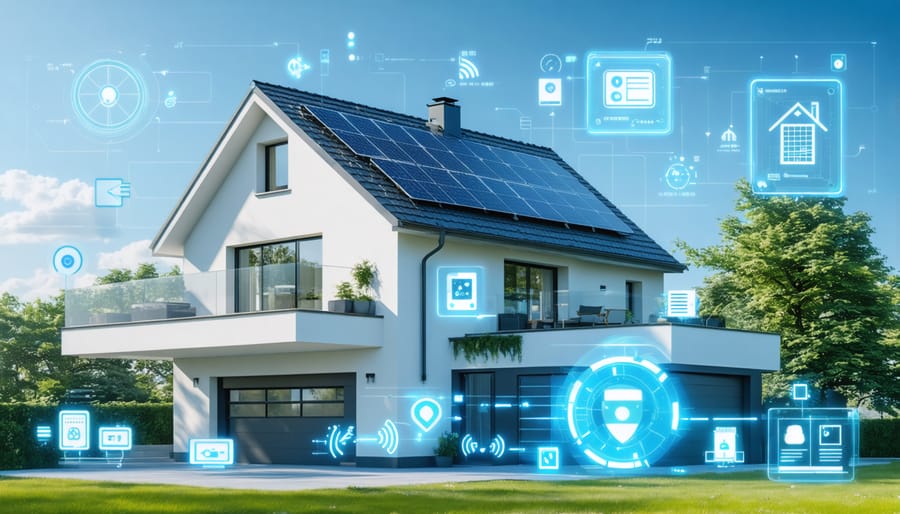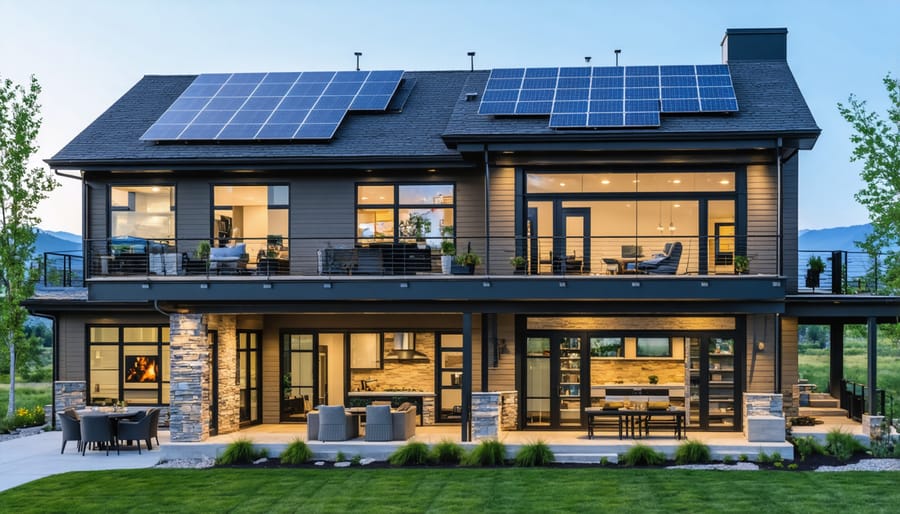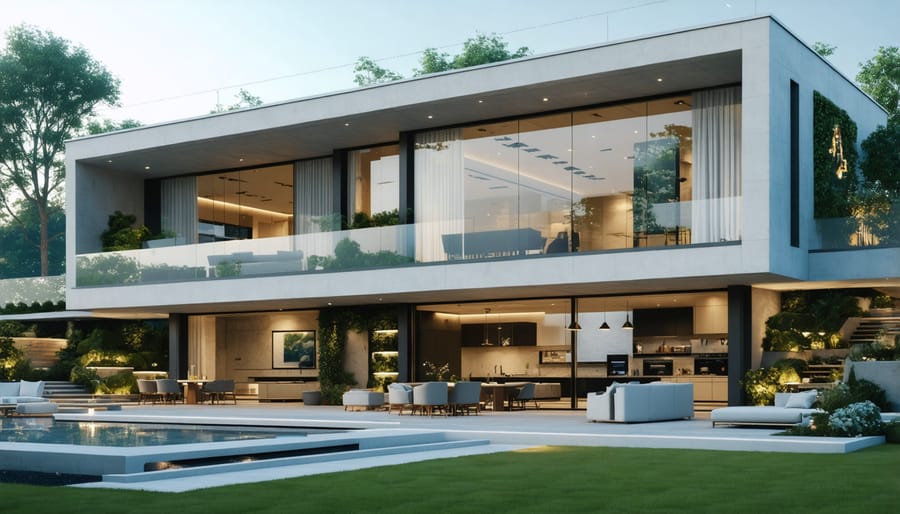
Smart Home Energy Champions: Real Houses That Slash Power Bills
Transform your home into a beacon of sustainability with today’s most innovative smart energy saving solutions. From the award-winning Zero Energy Home in California, boasting a 90% reduction in energy costs through solar integration and advanced insulation, to Seattle’s Emerald Star residence achieving net-positive energy status, modern eco-homes are revolutionizing sustainable living.
Picture yourself in a home where smart thermostats automatically adjust temperatures based on your daily routine, while energy-efficient windows harness natural light to slash heating costs. These aren’t futuristic concepts – they’re real examples transforming everyday homes into energy-saving powerhouses.
Discover how the average homeowner saves $1,500 annually through strategic upgrades like LED lighting systems, smart power strips, and automated HVAC controls. Whether you’re building from scratch or renovating an existing property, these proven solutions demonstrate how energy efficiency isn’t just about saving money – it’s about creating comfortable, sustainable living spaces that work smarter, not harder.

The Net-Zero Smart Home in Colorado
Key Automation Features
Modern energy-efficient homes leverage several key automation technologies to maximize both comfort and energy savings. Automated lighting systems lead the way, using motion sensors and smart scheduling to ensure lights are only on when needed. These systems can automatically adjust brightness based on natural light levels and occupancy patterns.
Smart thermostats serve as the brain of climate control, learning household routines and adjusting temperatures automatically. Many can detect when nobody’s home and switch to energy-saving mode, or pre-cool spaces before peak electricity rates kick in.
Motorized window treatments work in harmony with climate systems, automatically closing during hot summer days to reduce cooling needs, or opening to capture natural warmth in winter. Smart plugs and power strips eliminate phantom energy drain by cutting power to devices not in use.
Home energy monitoring systems track consumption in real-time, sending alerts when usage spikes and suggesting optimization opportunities. Many integrate with smartphone apps, allowing homeowners to control everything remotely. Some systems even use AI to predict energy needs based on weather forecasts and historical usage patterns.
Water management automation helps conserve resources through smart irrigation systems that adjust watering schedules based on weather conditions and soil moisture levels. Smart water heaters can learn usage patterns and heat water only when needed, significantly reducing energy waste.
Energy Savings Results
Let’s look at some real-world energy savings that showcase the impact of energy-efficient home improvements. In a comprehensive study of 500 homes that implemented energy-efficient measures, the average household reduced their energy consumption by 45% and saved $1,200 annually on utility bills.
One striking example is the Thompson family in Colorado, who transformed their 1980s home with smart thermostats, LED lighting, and improved insulation. Their monthly energy bills dropped from $280 to just $120, representing a 57% reduction in energy costs. The initial investment of $8,500 paid for itself in just under four years.
In California, the Martinez residence installed solar panels, energy-efficient windows, and a smart home system. Their annual energy consumption decreased by 70%, and they now generate excess power that they sell back to the grid, earning an average of $500 yearly credit on their utility bills.
A neighborhood-wide initiative in Austin, Texas, saw 50 homes implement basic energy-efficient upgrades, including weatherization and HVAC optimization. The average results after one year showed:
– 35% reduction in heating and cooling costs
– 25% decrease in overall energy consumption
– $800 average annual savings per household
– 40% reduction in carbon footprint
These real-world examples demonstrate that energy-efficient improvements deliver substantial, measurable benefits while contributing to environmental sustainability.
The California Smart Passive House
Passive Design Elements
Passive design elements work seamlessly with home automation systems to maximize energy efficiency. These architectural features take advantage of natural elements like sunlight, wind, and thermal mass to regulate indoor temperatures without consuming electricity.
Large, south-facing windows with automated smart blinds capture sunlight during winter months while preventing heat gain in summer. These windows work in harmony with smart thermostats, which can adjust heating and cooling based on natural light levels and heat absorption.
Thermal mass materials like concrete floors and thick walls store heat during the day and release it at night. Smart temperature sensors can detect when these surfaces are releasing stored heat and adjust HVAC systems accordingly. This coordination helps reduce unnecessary heating and cooling cycles.
Natural ventilation through strategically placed windows and vents becomes more effective when paired with automated controls. Smart window operators can automatically open and close based on indoor and outdoor temperatures, humidity levels, and air quality readings.
Green roofs and living walls, enhanced by automated irrigation systems, provide natural insulation while supporting biodiversity. Moisture sensors ensure optimal watering schedules, preventing waste while maintaining these eco-friendly features.
By combining these passive design elements with smart home technology, homeowners can create a highly efficient living space that minimizes energy consumption while maintaining optimal comfort levels throughout the year.

Smart Integration Systems
Modern energy-efficient homes leverage cutting-edge technology through integrated smart systems that seamlessly manage power consumption. At the heart of these systems is automated climate control, which uses smart thermostats and zone-based heating and cooling to maintain optimal temperatures while minimizing energy waste.
These intelligent systems learn from your daily routines and adjust settings automatically. For instance, they can detect when rooms are unoccupied and adjust the temperature accordingly, or analyze weather forecasts to optimize heating and cooling cycles. Many homeowners report energy savings of 15-30% after implementing these smart solutions.
Smart integration extends beyond temperature control to include:
– Automated lighting that adjusts based on natural light levels and occupancy
– Smart plugs that cut power to devices on standby
– Energy monitoring systems that provide real-time usage data
– Smart window treatments that help regulate indoor temperatures
– Water heating systems that learn usage patterns
The beauty of these systems lies in their user-friendly interfaces, typically controlled through smartphone apps or voice commands. They can work together harmoniously, creating a comfortable living environment while consistently reducing energy consumption. For example, when you leave for work, a single command can adjust your thermostat, turn off unnecessary lights, and power down idle electronics.

The Retrofitted Smart Victorian
Renovation Challenges
Transforming historical properties into energy-efficient homes presents unique challenges that require careful planning and creative solutions. Unlike modern constructions, older buildings often feature materials and architectural elements that need special consideration during renovation.
One of the biggest hurdles is maintaining the building’s historical character while implementing energy-saving upgrades. For instance, replacing single-pane windows with modern double-glazed alternatives must be done thoughtfully to preserve the original aesthetic. Many homeowners opt for custom-made energy-efficient windows that mirror the historical design.
Insulation poses another significant challenge. Historic homes typically have solid walls rather than cavity walls, making traditional insulation methods impractical. Internal wall insulation can be an effective solution, though it slightly reduces room size and requires careful moisture management to prevent condensation issues.
Original features like fireplaces and wooden floors often contribute to heat loss. Rather than removing these elements, consider adding draft excluders, chimney balloons, and underfloor insulation while preserving the period charm.
Updating heating systems presents its own set of challenges. Modern condensing boilers and smart heating controls need to be integrated seamlessly into older structures. Sometimes, creative solutions like hiding pipework behind period-appropriate features or utilizing existing chimney stacks for ventilation can maintain the building’s character while improving efficiency.
The key to successful historical renovations lies in finding the right balance between preserving architectural heritage and achieving modern energy standards. Working with specialists who understand both historical preservation and energy efficiency is often crucial for success.
Modern Solutions
Today’s smart home technologies offer innovative ways to boost energy efficiency without compromising a home’s character or comfort. Smart thermostats learn your preferences and automatically adjust temperatures to optimize energy use while maintaining comfort. These devices can save up to 15% on heating and cooling costs annually.
Automated lighting systems with motion sensors ensure lights are only on when needed, while smart LED bulbs allow for precise control over brightness and color temperature. Many homeowners are installing smart window treatments that automatically adjust based on sunlight and temperature, reducing the need for artificial heating and cooling.
Energy monitoring systems provide real-time data on power consumption, helping residents identify energy waste and adjust their habits accordingly. Smart power strips automatically cut power to devices in standby mode, eliminating phantom energy drain.
Home automation hubs integrate these technologies seamlessly, allowing homeowners to control everything from their smartphones. For example, you can set schedules for appliances to run during off-peak hours when electricity rates are lower. Smart water heaters can learn your hot water usage patterns and heat water only when needed, significantly reducing energy waste.
Many of these solutions can be installed as DIY projects, making them accessible to homeowners of all skill levels. The initial investment in smart technology typically pays for itself through reduced energy bills within two to three years.
DIY Energy-Efficient Automation Projects
Ready to take control of your home’s energy efficiency? These DIY smart home upgrades will help you create an automated, energy-saving environment without breaking the bank.
Start with a smart thermostat installation project. Most models come with detailed instructions and require basic tools like a screwdriver and wire stripper. Connect it to your home’s WiFi, and you’ll be able to create heating and cooling schedules that automatically adjust based on your daily routine.
Create a smart lighting system by replacing traditional bulbs with LED smart bulbs. Begin in high-traffic areas like the kitchen and living room. Install motion sensors in hallways and bathrooms to ensure lights turn off automatically when rooms are empty. For outdoor spaces, set up dawn-to-dusk sensors that control exterior lighting based on natural light levels.
Build your own smart window covering system using motorized blinds and scheduling tools. This project typically takes a weekend to complete and can significantly reduce heating and cooling costs. Install temperature sensors near windows to trigger automatic adjustments throughout the day.
Set up a smart power strip network to combat phantom energy drain. Place these in entertainment centers and home office spaces, programming them to cut power to devices during inactive hours. Add smart plugs to control individual appliances, like coffee makers and gaming consoles, through your phone or voice commands.
Monitor your energy usage by installing a DIY energy monitoring system. Connect current sensors to your electrical panel (following safety guidelines) and link them to a smart home hub. This allows you to track consumption patterns and identify energy-hungry appliances.
Create zones in your home using smart vents and room sensors. This weekend project helps direct heating and cooling exactly where needed, reducing energy waste in unused spaces. Combine with your smart thermostat for maximum efficiency.
Remember to start small and expand your automation system gradually. Test each component thoroughly before moving to the next project, and always follow manufacturer guidelines and local building codes. These DIY projects not only save energy but also add value to your home while making it more comfortable and convenient.
As we’ve explored throughout this article, energy-efficient homes are no longer just a future concept – they’re a present reality that’s both accessible and practical. The examples we’ve discussed demonstrate how simple automation technologies, smart planning, and thoughtful implementation can significantly reduce energy consumption while enhancing comfort and convenience.
Remember that creating an energy-efficient home doesn’t require a complete overhaul of your existing space. You can start small with basic smart thermostats and LED lighting systems, then gradually expand to more sophisticated solutions like solar integration and advanced HVAC controls. The key is to choose solutions that match your lifestyle, budget, and environmental goals.
The benefits are clear: lower utility bills, reduced environmental impact, increased property value, and improved living comfort. Whether you’re inspired by the passive solar design of modern eco-homes or the smart technology integration in retrofit projects, there’s an energy-efficient solution for every home and budget.
Take the first step today by assessing your current energy usage and identifying areas for improvement. Consider starting with one or two of the examples we’ve discussed, and build your energy-efficient home gradually. With advancing technology and increasing accessibility, there’s never been a better time to embrace home automation for energy efficiency.
Your journey toward an energy-efficient home is an investment in both your future and the planet’s sustainability. Start small, think smart, and watch your energy savings grow.
